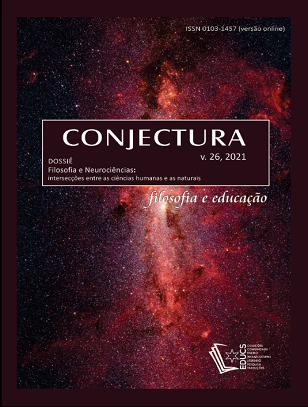Corporeal affinities:affective Neuroscience and empathy
DOI:
https://doi.org/10.18226/21784612.v26.e021006Abstract
In recent decades, neurosciences have reached considerable goals in understanding mental processes and human behavior, overcoming the classic separations between mind and body, reason and passion, penetrating the maze of our cognitive and emotional life to explain their rootedness in the body and the their interactions with the environment. And if until not many years ago psychological and neuroscientific research neglected the study of emotional life to focus only on cognitive functions tout court, today there is even a dedicated sector called affective Neuroscience. By broadly reconstructing the general panorama of neuroscience, and of the affective ones in particular, this essay focuses on the contribution that research on mirror neurons has made to understanding the mechanisms of intersubjectivity and above all that component of social cognition that is empathy. The goal is to understand how we recognize the emotions of others and to explain what the human ability to interpret the actions and intentions of others as if they were ours, to know better how we work and how we relate to others. Research on mirror neurons, within an embodied perspective, shows how the brain is an organ linked to a body that acts, moves and feels in its unceasing interaction with the world.
Keywords: Neuroscience. Affective Neurosciences. Emotions. Empathy.
Mirror neurons. Embodied cognition.
References
BARON-COHEN, S. La scienza del male. L’empatia e le origini della crudeltà. Trad. do it. Milano: R. Cortina, 2012 (ed. or. 2011).
BARRETT, L.F. How emotions are made: The secret life of the brain. Boston and New York: Houghton Mifflin Harcourt, 2017.
BEAR, M.F., CONNORS, B.W., PARADISO, M.A. Neuroscienze. Esplorando il cervello. Trad. do it. 3ª ed. Milano: Elsevier Masson, 2007 (ed. or. 2007).
BOURRET, M. La cassetta degli attrezzi dell’empatia. Trad. do it. Torino: Edizioni Amrita, 2013 (ed. or. 2010).
CERONI, M., VANZAGO, L. La coscienza. Contributi per specialisti e non specialisti tra neuroscienze, filosofia e neurologia. Fano (PU): Aras Edizioni, 2014.
DAMASIO, A. L’errore di Cartesio. Emozione, ragione e cervello umano. Trad. do it. Milano: Adelphi, 1995 (ed. or. 1994).
DAMASIO, A. Alla ricerca di Spinoza. Emozioni, sentimenti e cervello. Trad. do it. Milano: Adelphi, 2003 (ed. or. 2003).
DAVIDSON, R.J., BEGLEY, S. La vita emotiva del cervello. Trad. do it. Milano: Ponte delle Grazie, 2013 (ed. or. 2012).
DE VECCHI, F. Il paesaggio sociale: essenza e forme degli atti di empatia. Bollettino filosofico, 33, 2018, pp. 85-99 (n. monografico su Ripensare la fenomenologia, con e oltre).
DUNCAN, S., BARRETT, L.F. Affect is a form of cognition: A neurobiological analysis. Cognition and Emotion, V 21(6), 2007, pp. 1184-1211.
GALLESE, V. Dai neuroni specchio alla consonanza intenzionale. Meccanismi neurofisiologici dell’intersoggettività. Rivista di Psicoanalisi, LIII, 1., 2007, pp. 197-208.
GAZZANIGA, M.S., LE DOUX, J.E. The integrated mind. Springer, US, 1978.
KANDEL, E.R., SCHWARTZ, J.H., JESSELL, T.M. Principi di neuroscienze. Trad. do it. 3ª ed. Milano: Casa Editrice Ambrosiona, 2003 (ed. or. 2000).
LE DOUX, J.E. Il cervello emotivo. Alle origini delle emozioni. Trad. do it. Milano: Baldini Castoldi, 1998 (ed. or. 1996).
LE DOUX, J.E. Il sé sinaptico. Come il nostro cervello ci fa diventare quelli che siamo. Trad. do it. Milano: Cortina, 2002 (ed. or. 2001).
LEGRENZI, P. Prima lezione di scienze cognitive. Roma-Bari: Laterza, 2010.
LOMBARDO, G. So quel che (non) sai. Una divagazione sull’empatia. Aestetica preprint, 100, 2015, pp. 85-89.
MACLEAN P. D. The triune brain in evolution. Role in paleocerebral functions. New York: Plenum Press, 1990.
MARRAFFA, M. Percezione, pensiero, coscienza. Passato e futuro delle scienze della mente. Torino: Rosenberg & Sellier, 2019.
MICHELETTI, L., Empatia e comunicazione non verbale. Cosenza: Pellegrini Editore, 2017.
NIEDENTHAL, P. Embodying emotion. Science (316), 2007, pp. 1002-1005.
PANKSEPP J., BIVEN L. Archeologia della mente: origini neuroevolutive delle emozioni umane. Trad. do it. Milano: Raffaello Cortina, 2014 (ed. or. 2012).
RIZZOLATTI, G. SINIGAGLIA, C. So quel che fai. Il cervello che agisce e i neuroni specchio. Milano: Raffaello Cortina, 2006.
RIZZOLATTI, G., GNOLI, A. In te mi specchio. Per una scienza dell’empatia. Milano: Rizzoli, 2016.
RIZZOLATTI, G., SINIGAGLIA, C. Specchi nel cervello. Come comprendiamo gli altri dall’interno. Milano: Cortina, 2019.
ROGANTI, D., RICCI BITTI, A. Empatia ed emozioni: alcune riflessioni sui neuroni specchio. Giornale Italiano di Psicologia, XXXIX, 3, sett. 2012, pp. 565-590.
ZRZNARIC, R. Empatia. Perché è importante e come metterla in pratica. Trad. do it. Roma: Armando Editore, 2018 (ed. or. 2014).
Downloads
Published
How to Cite
Issue
Section
License
1. The publication of the originals will imply the assignment of copyright to Conjectura Journal.
2. Texts cannot be reproduced without authorization from the Journal after acceptance.









